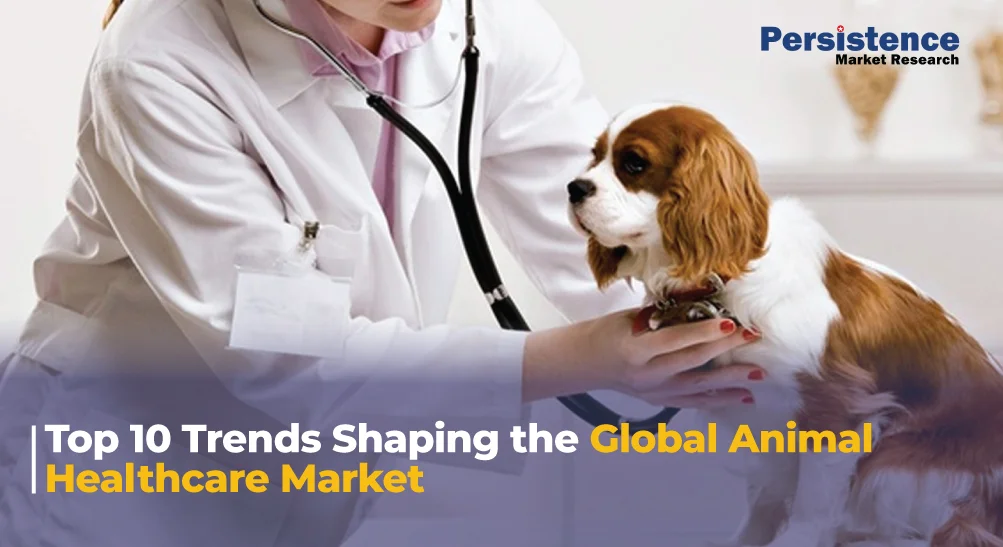- Blog
- Animal Healthcare Market
Top 10 Trends Shaping the Global Animal Healthcare Market
Published On : 19 Sep 2025
The global animal healthcare market is in a period of transition where science, regulation, and consumer demand intersect. Rising pet ownership, new biologics, advanced diagnostics and heightened attention to food safety are creating measurable shifts in both companion animal and livestock care. Unlike earlier decades, when growth was largely volume-driven, today’s market reflects deeper structural changes that are reshaping investment priorities and product pipelines. Understanding these forces provides a clearer picture of where opportunities and challenges are emerging across the industry.

1. Commercialization of Species-Specific Biologics
Monoclonal antibodies and other targeted biologics for dogs and cats have moved from experimental use into routine practice. A notable example is lokivetmab, used for canine atopic dermatitis. These therapies mark a shift toward single-target immunotherapies that reshape treatment pathways and establish new pricing tiers in specialty care. Clinical follow-up data and company records continue to show strong efficacy, which supports growing adoption.
2. Parasiticide Innovation and Combination Therapies
Recent product approvals highlight broad-spectrum, combination oral treatments for parasite control in companion animals. By combining multiple prophylactic functions into a single dosage, these therapies simplify care for owners and create measurable unit growth in parasiticide markets. The shift is also influencing purchasing patterns among farmers and pet owners.
3. Decentralized, Rapid Diagnostics with Herd-Level Analytics
Portable PCR devices, rapid antigen tests, and compact in-clinic analyzers are bringing laboratory-level capabilities directly to clinics and farms. When connected to herd-management dashboards, these tools provide actionable insights, including incidence rates and treatment-response data. Large producers increasingly rely on these metrics to guide operational decisions.
4. Differential Adoption across Segments
Spending patterns in animal healthcare diverge between companion and production animals. Companion-animal care is experiencing higher per-capita growth in specialty therapeutics, diagnostics, and chronic-disease management. In contrast, production-animal healthcare is concentrated on vaccines, biosecurity, and productivity-enhancing interventions, particularly within large-scale commercial operations.
5. Regulatory-Driven Declines in Antibiotic Use
Regulatory reforms and routine surveillance have led to measurable reductions in veterinary antibiotic sales across major markets. The European Medicines Agency, among others, publishes harmonized reports that confirm these declines. The resulting shift has fueled wider use of vaccines, probiotics, and non-antibiotic alternatives.
6. Telemedicine Expansion in a Complex Legal Landscape
Veterinary telemedicine is expanding, but its development is shaped by differing legal frameworks. Most jurisdictions require an established veterinarian-client-patient relationship before remote diagnosis or prescribing can take place. In the United States, some states have revised laws to clarify what is permitted. This mix of permissive and restrictive rules influences how platforms are built and where they can operate.
7. Pricing Segmentation and Localized Strategies
Growth in regions such as Asia, Latin America and parts of Africa is tempered by high price sensitivity. To address this, companies are tailoring product strategies with generics, affordable diagnostics, and adapted packaging. Premium biologics and advanced diagnostics continue to dominate higher-margin markets in North America and Europe.
8. Cold-Chain Dependency and Regional Manufacturing Pressures
The rise of biologics and vaccines has increased the importance of cold-chain logistics and localized production. Delays in manufacturing or distribution disruptions now pose significant risks, especially in markets with weaker infrastructure. Regional fill-and-finish capacity is becoming a critical factor in ensuring consistent access.
9. Data as a Commercial Asset
Veterinary practice management systems, diagnostic networks and wearable health monitors are generating large volumes of clinical data. These datasets are gaining commercial value through licensing agreements, analytics partnerships and patent activity. They are increasingly used for pharmacovigilance, product validation and epidemiological modeling.
10. Concentration of R&D through Strategic Deals
Research and product development in animal healthcare are increasingly shaped by mergers, acquisitions and licensing agreements. Large multinational firms maintain broad portfolios across vaccines, pharmaceuticals and diagnostics, while partnerships with biotech companies and academic institutions accelerate the commercialization of new technologies.
Conclusion
The global animal healthcare market is no longer defined by incremental growth alone. It is being reshaped by biologics tailored to specific species, faster and more decentralized diagnostics, and stricter regulatory frameworks that are changing the role of antibiotics. Digital health tools, evolving telemedicine practices and the commercial value of veterinary data are adding new dimensions to how care is delivered and measured.
Regional variations in pricing and infrastructure continue to shape access and adoption. The result is a market that is more diverse, specialized and data-driven than in previous decades, with clear signals of long-term transformation across both companion and production animal care.
Industry Report

Request Report Sample
Your privacy is important to us; your data is secure
Contact Us
Latest Reports
-
Structured Content and Product Label Management Market by Solution Type (Software, Services), Deployment Model (Cloud-based, Others), Application (Pharmaceuticals, Others), Functionality (Label Design, Version Control, Others), and Regional Analysis for 2025 - 2032
-
Europe UK, and Australia Electric Blanket Market by Product Type (Under Blankets, Over Blankets, Misc.), Material Type (Wool, Cotton, Polyester, Acrylic, Misc.), Size (Single Size, Double Size, King Size.), End-user (Commercial, Residential.), Distribution Channel (Supermarkets and Hypermarkets, Specialty Stores, Online Stores, Misc.), and Regional Analysis for 2026 - 2033
-
Foundation Repair Services Market by Service type (Settlement Repair, Wall Repair, Chimney Repair, Floor Slab Repair, Others), End-user (Residential, Commercial), and Regional Analysis for 2026 - 2033
-
Food Grade Phosphoric Acid Market By Product Form (Liquid, Solid, Others), Applications (Food & Beverages, Pharmaceuticals, Animal Feed, Others), and Regional Analysis for 2026 - 2033
-
Coconut Oil Market By Product Type (Virgin, Extra Virgin, Refined, Others), Source (Organic, Conventional), Application (Food & Beverage, Cosmetics, Others), Distribution Channel (Supermarket/Hypermarket, Others), and Regional Analysis for 2026 - 2033
